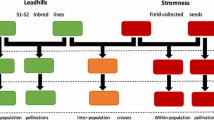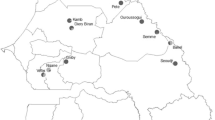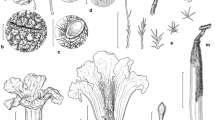Abstract
Whole-genome duplication (WGD) is a leading force of plant sympatric speciation. However, the evolutionary mechanisms promoting the establishment of neopolyploid mutants in nature remain elusive. We studied polyploid establishment in a unique natural system of Mimulus guttatus (Phrymaceae) in Shetland where a recently (< 100 years ago) locally formed autotetraploid still coexists with its diploid progenitor. We cytotyped 679 adults and 766 seedlings and scored relevant reproductive traits in the field and performed controlled crossings to infer differences in plant performance and get a first insight into the crossing barriers between ploidies. Tetraploids grew in 25% of Shetland populations, mostly in mixtures with diploids, but triploids were absent both among seedlings and adults. Seeds of both cytotypes sampled in areas of immediate sympatry exhibited similar, high germination rates (98% on average). In contrast, low (2%) germination of progeny from controlled interploidy crosses demonstrated strong postzygotic isolation. Yet, plants simultaneously pollinated by diploid and tetraploid pollen donors set viable progeny with ploidy levels identical to the seed parent. The abundant presence of fertile tetraploids in the field despite strong postzygotic isolation demonstrates the ability of novel autopolyploids to cope with both intrinsic and extrinsic challenges associated with WGD and to successfully establish in nature.




Similar content being viewed by others
Data availability
All data for this study are available as supplementary data.
References
Arrigo N, Barker MS (2012) Rarely successful polyploids and their legacy in plant genomes. Curr Opin Pl Biol 15:140–146. https://doi.org/10.1016/j.pbi.2012.03.010
Baack EJ (2005) Ecological factors influencing tetraploid establishment in snow buttercups (Ranunculus adoneus, Ranunculaceae): minority cytotype exclusion and barriers to triploid formation. Amer J Bot 92:1827–1835. https://doi.org/10.3732/ajb.92.11.1827
Baldwin SJ, Husband BC (2011) Genome duplication and the evolution of conspecific pollen precedence. Proc Roy Soc B, Biol Sci 278:2011–2017. https://doi.org/10.1098/rspb.2010.2208
Bates D, Mächler M, Bolker B, Walker S (2014) Fitting linear mixed-effects models using lme4. J Stat Softw 67:1–48. https://doi.org/10.18637/jss.v067.i01
Bohutínská M, Alston M, Monnahan P, Mandáková T, Bray S, Paajanen P, Kolář F, Yant L (2021a) Novelty and convergence in adaptation to whole genome duplication. Molec Biol Evol 38:3910–3924. https://doi.org/10.1093/molbev/msab096
Bohutínská M, Vlček J, Yair S, Laenen B, Konečná V, Fracassetti M, Slotte T, Kolář F (2021b) Genomic basis of parallel adaptation varies with divergence in Arabidopsis and its relatives. Proc Natl Acad Sci USA 118:e2022713118. https://doi.org/10.1073/pnas.2022713118
Bomblies K, Madlung A (2014) Polyploidy in the Arabidopsis genus. Chromosome Res 22:117–134. https://doi.org/10.1007/s10577-014-9416-x
BSBI (1836) BSBI (Botanical Society of Britain and Ireland) distribution database. Available at: https://database.bsbi.org/. Accessed 29 Aug 2023
Castro S, Münzbergová Z, Raabová J, Loureiro J (2011) Breeding barriers at a diploid–hexaploid contact zone in Aster amellus. Evol Ecol 25:795–814. https://doi.org/10.1007/s10682-010-9439-5
Castro M, Loureiro J, Husband BC, Castro S (2020) The role of multiple reproductive barriers: strong post-pollination interactions govern cytotype isolation in a tetraploid–octoploid contact zone. Ann Bot (Oxford) 126:991–1003. https://doi.org/10.1093/aob/mcaa084
Clo J (2022) Polyploidization: consequences of genome doubling on the evolutionary potential of populations. Amer J Bot 109:1213–1220. https://doi.org/10.1002/ajb2.16029
Clo J, Kolář F (2021) Short- and long-term consequences of genome doubling: a meta-analysis. Amer J Bot 108:2315–2322. https://doi.org/10.1002/ajb2.1759
Clo J, Padilla-García N, Kolář F (2022) Polyploidization as an opportunistic mutation: the role of unreduced gametes formation and genetic drift in polyploid establishment. J Evol Biol 35:1099–1109. https://doi.org/10.1111/jeb.14055
Coughlan JM, Wilson Brown M, Willis JH (2020) Patterns of hybrid seed inviability in the Mimulus guttatus sp. complex reveal a potential role of parental conflict in reproductive isolation. Curr Biol 30:83-93.e5. https://doi.org/10.1016/j.cub.2019.11.023
Dolezel J, Greilhuber J, Suda J (2007) Estimation of nuclear DNA content in plants using flow cytometry. Nat Protoc 2:2233–2244. https://doi.org/10.1038/nprot.2007.310
Doyle JJ, Coate JE (2019) Polyploidy, the nucleotype, and novelty: the impact of genome doubling on the biology of the cell. Int J Pl Sci 180:1–52. https://doi.org/10.1086/700636
Fishman L, Aagaard J, Tuthill JC (2008) Toward the evolutionary genomics of gametophytic divergence: patterns of transmission ratio distortion in monkeyflower (Mimulus) hybrids reveal a complex genetic basis for conspecific pollen precedence. Evolution 62:2958–2970. https://doi.org/10.1111/j.1558-5646.2008.00475.x
Fowler NL, Levin DA (2016) Critical factors in the establishment of allopolyploids. Amer J Bot 103:1236–1251. https://doi.org/10.3732/ajb.1500407
Gaynor ML, Kortessis N, Soltis DE, Soltis PS, Ponciano JM (2023) Dynamics of mixed-ploidy populations under demographic and environmental stochasticities. bioRxiv 2023.03.29.534764. https://doi.org/10.1101/2023.03.29.534764
Griswold CK (2021) The effects of migration load, selfing, inbreeding depression, and the genetics of adaptation on autotetraploid versus diploid establishment in peripheral habitats. Evolution 75:39–55. https://doi.org/10.1111/evo.14127
Hanzl M, Kolář F, Nováková D, Suda J (2014) Nonadaptive processes governing early stages of polyploid evolution: insights from a primary contact zone of relict serpentine Knautia arvensis (Caprifoliaceae). Amer J Bot 101:935–945. https://doi.org/10.3732/ajb.1400005
Hazzouri KM, Mohajer A, Dejak SI, Otto SP, Wright SI (2008) Contrasting patterns of transposable-element insertion polymorphism and nucleotide diversity in autotetraploid and allotetraploid Arabidopsis species. Genetics 179:581–592. https://doi.org/10.1534/genetics.107.085761
Husband BC (2000) Constraints on polyploid evolution: a test of the minority cytotype exclusion principle. Proc Biol Sci 267:217–223. https://doi.org/10.1098/rspb.2000.0990
Husband BC (2004) The role of triploid hybrids in the evolutionary dynamics of mixed-ploidy populations: triploids in mixed-ploidy populations. Biol J Linn Soc 82:537–546. https://doi.org/10.1111/j.1095-8312.2004.00339.x
Husband BC, Sabara HA (2004) Reproductive isolation between autotetraploids and their diploid progenitors in fireweed, Chamerion angustifolium (Onagraceae). New Phytol 161:703–713. https://doi.org/10.1046/j.1469-8137.2004.00998.x
Husband BC, Schemske DW, Burton TL, Goodwillie C (2002) Pollen competition as a unilateral reproductive barrier between sympatric diploid and tetraploid Chamerion angustifolium. Proc Roy Soc London Ser B, Biol Sci 269:2565–2571. https://doi.org/10.1098/rspb.2002.2196
Husband BC, Ozimec B, Martin SL, Pollock L (2008) Mating consequences of polyploid evolution in flowering plants: current trends and insights from synthetic polyploids. Int J Pl Sci 169:195–206. https://doi.org/10.1086/523367
Jersáková J, Castro S, Sonk N, Milchreit K, Schödelbauerová I, Tolasch T, Dötterl S (2010) Absence of pollinator-mediated premating barriers in mixed-ploidy populations of Gymnadenia conopsea s.l. (Orchidaceae). Evol Ecol 24:1199–1218. https://doi.org/10.1007/s10682-010-9356-7
Kennedy BF, Sabara HA, Haydon D, Husband BC (2006) Pollinator-mediated assortative mating in mixed ploidy populations of Chamerion angustifolium (Onagraceae). Oecologia 150:398–408. https://doi.org/10.1007/s00442-006-0536-7
Kolář F, Fér T, Štech M, Trávníček P, Dušková E, Schönswetter P, Suda J (2012) Bringing together evolution on serpentine and polyploidy: spatiotemporal history of the diploid-tetraploid complex of Knautia arvensis (Dipsacaceae). PLoS ONE 7:e39988. https://doi.org/10.1371/journal.pone.0039988
Kolář F, Čertner M, Suda J, Schönswetter P, Husband BC (2017) Mixed-ploidy species: progress and opportunities in polyploid research. Trends Pl Sci 22:1041–1055. https://doi.org/10.1016/j.tplants.2017.09.011
Koutecký P, Baďurová T, Štech M, Košnar J, Karásek J (2011) Hybridization between diploid Centaurea pseudophrygia and tetraploid C. jacea (Asteraceae): the role of mixed pollination, unreduced gametes, and mentor effects. Biol J Linn Soc 104:93–106
Laport RG, Minckley RL, Pilson D (2021) Pollinator assemblage and pollen load differences on sympatric diploid and tetraploid cytotypes of the desert-dominant Larrea tridentata. Amer J Bot 108:297–308. https://doi.org/10.1002/ajb2.1605
Levin DA (1975) Minority cytotype exclusion in local plant populations. Taxon 24:35–43. https://doi.org/10.2307/1218997
Levin DA (1983) Polyploidy and novelty in flowering plants. Amer Naturalist 122:1–25
Lipnerová I, Bures P, Horová L, Smarda P (2013) Evolution of genome size in Carex (Cyperaceae) in relation to chromosome number and genomic base composition. Ann Bot (Oxford) 111:79–94. https://doi.org/10.1093/aob/mcs239
Martin NH, Willis JH (2007) Ecological divergence associated with mating system causes nearly complete reproductive isolation between sympatric Mimulus species. Evolution 61:68–82. https://doi.org/10.1111/j.1558-5646.2007.00006.x
Meeus S, Šemberová K, De Storme N, Geelen D, Vallejo-Marín M (2020) Effect of whole genome duplication on the evolutionary rescue of sterile hybrid monkeyflowers. Pl Commun 1:100093. https://doi.org/10.1016/j.xplc.2020.100093
Monnahan P, Kolář F, Baduel P, Sailer C, Koch J, Horvath R, Laenen B, Schmickl R, Paajanen P, Šrámková G, Bohutínská M, Arnold B, Weisman CM, Marhold K, Slotte T, Bomblies K, Yant L (2019) Pervasive population genomic consequences of genome duplication in Arabidopsis arenosa. Nat Ecol Evol 3:457–468. https://doi.org/10.1038/s41559-019-0807-4
Morgan EJ, Čertner M, Lučanová M, Deniz U, Kubíková K, Venon A, Kovářík O, Lafon Placette C, Kolář F (2021) Disentangling the components of triploid block and its fitness consequences in natural diploid–tetraploid contact zones of Arabidopsis arenosa. New Phytol 232:1449–1462. https://doi.org/10.1111/nph.17357
Oswald BP, Nuismer SL (2011) A unified model of autopolyploid establishment and evolution. Amer Naturalist 178:687–700. https://doi.org/10.1086/662673
Otto SP, Whitton J (2000) Polyploid incidence and evolution. Annual Rev Genet 34:401–437. https://doi.org/10.1146/annurev.genet.34.1.401
Parisod C, Holderegger R, Brochmann C (2010) Evolutionary consequences of autopolyploidy. New Phytol 186:5–17. https://doi.org/10.1111/j.1469-8137.2009.03142.x
Peterson R, Slovin JP, Chen C (2010) A simplified method for differential staining of aborted and non-aborted pollen grains. Int J Pl Biol 1:e13. https://doi.org/10.4081/pb.2010.e13
Porturas LD, Anneberg TJ, Curé AE, Wang S, Althoff DM, Segraves KA (2019) A meta-analysis of whole genome duplication and the effects on flowering traits in plants. Amer J Bot 106:469–476. https://doi.org/10.1002/ajb2.1258
Ramsey J, Schemske DW (1998) Pathways, mechanisms, and rates of polyploid formation in flowering plants. Annual Rev Ecol Syst 29:467–501. https://doi.org/10.1146/annurev.ecolsys.29.1.467
Ramsey J, Schemske DW (2002) Neopolyploidy in flowering plants. Annual Rev Ecol Syst 33:589–639. https://doi.org/10.1146/annurev.ecolsys.33.010802.150437
Ramsey J, Bradshaw HD, Schemske DW (2003) Components of reproductive isolation between the monkeyflowers Mimulus lewisii and M. cardinalis (Phrymaceae). Evolution 57:1520–1534. https://doi.org/10.1111/j.0014-3820.2003.tb00360.x
Rausch JH, Morgan MT (2005) The effect of self-fertilization, inbreeding depression, and population size on autopolyploid establishment. Evolution 59:1867–1875
Rezende L, Suzigan J, Amorim FW, Moraes AP (2020) Can plant hybridization and polyploidy lead to pollinator shift? Acta Bot Brasil 34:229–242. https://doi.org/10.1590/0102-33062020abb0025
Ritland K (1989) Correlated matings in the partial selfer Mimulus guttatus. Evolution 43:848–859. https://doi.org/10.1111/j.1558-5646.1989.tb05182.x
Ritland K, Ganders FR (1987) Covariation of selfing rates with parental gene fixation indices within populations of Mimulus guttatus. Evolution 41:760–771. https://doi.org/10.1111/j.1558-5646.1987.tb05851.x
Roccaforte K, Russo SE, Pilson D (2015) Hybridization and reproductive isolation between diploid Erythronium mesochoreum and its tetraploid congener E. albidum (Liliaceae). Evolution 69:1375–1389. https://doi.org/10.1111/evo.12666
Segraves KA, Anneberg TJ (2016) Species interactions and plant polyploidy. Amer J Bot 103:1326–1335. https://doi.org/10.3732/ajb.1500529
Segraves KA, Thompson JN (1999) Plant polyploidy and pollination: floral traits and insect visits to diploid and tetraploid Heuchera grossulariifolia. Evolution 53:1114–1127. https://doi.org/10.1111/j.1558-5646.1999.tb04526.x
Simón-Porcar VI, Silva JL, Meeus S, Higgins JD, Vallejo-Marín M (2017) Recent autopolyploidization in a naturalized population of Mimulus guttatus (Phrymaceae). Bot J Linn Soc 185:189–207. https://doi.org/10.1093/botlinnean/box052
Šingliarová B, Zozomová-Lihová J, Mráz P (2019) Polytopic origin and scale-dependent spatial segregation of cytotypes in primary diploid–autopolyploid contact zones of Pilosella rhodopea (Asteraceae). Biol J Linn Soc 127:173–173. https://doi.org/10.1093/biolinnean/blz035
Soltis DE, Soltis PS (1999) Polyploidy: recurrent formation and genome evolution. Trends Ecol Evol 14:348–352. https://doi.org/10.1016/s0169-5347(99)01638-9
Stace C (2010) New Flora of the British Isles, 3rd edn. Cambridge University Press, Cambridge
Stebbins GL (1985) Polyploidy, hybridization, and the invasion of new habitats. Ann Missouri Bot Gard 72:824. https://doi.org/10.2307/2399224
Suda J, Herben T (2013) Ploidy frequencies in plants with ploidy heterogeneity: fitting a general gametic model to empirical population data. Proc Roy Soc B 280:20122387. https://doi.org/10.1098/rspb.2012.2387
Sutherland BL, Galloway LF (2017) Postzygotic isolation varies by ploidy level within a polyploid complex. New Phytol 213:404–412. https://doi.org/10.1111/nph.14116
Thompson JD, Lumaret R (1992) The evolutionary dynamics of polyploid plants: origins, establishment and persistence. Trends Ecol Evol 7:302–307. https://doi.org/10.1016/0169-5347(92)90228-4
Thompson JN, Merg KF (2008) Evolution of polyploidy and the diversification of plant–pollinator interactions. Ecology 89:2197–2206. https://doi.org/10.1890/07-1432.1
Trávnícek P, Dockalová Z, Rosenbaumová R, Kubátová B, Szelag Z, Chrtek J (2011) Bridging global and microregional scales: ploidy distribution in Pilosella echioides (Asteraceae) in central Europe. Ann Bot (Oxford) 107:443–454. https://doi.org/10.1093/aob/mcq260
Vallejo-Marín M, Cooley AM, Lee MY, Folmer M, McKain MR, Puzey JR (2016) Strongly asymmetric hybridization barriers shape the origin of a new polyploid species and its hybrid ancestor. Amer J Bot 103:1272–1288. https://doi.org/10.3732/ajb.1500471
Vallejo-Marín M, Friedman J, Twyford AD, Lepais O, Ickert-Bond SM, Streisfeld MA, Yant L, van Kleunen M, Rotter MC, Puzey JR (2021) Population genomic and historical analysis suggests a global invasion by bridgehead processes in Mimulus guttatus. Commun Biol 4:327. https://doi.org/10.1038/s42003-021-01795-x
Vallejo-Marin M, Lye GC (2013) Hybridisation and genetic diversity in introduced Mimulus (Phrymaceae). Heredity 110:111–122. https://doi.org/10.1038/hdy.2012.91
Van Drunen WE, Friedman J (2022) Autopolyploid establishment depends on life-history strategy and the mating outcomes of clonal architecture. Evolution 76:1953–1970. https://doi.org/10.1111/evo.14582
Van Drunen WE, Husband BC (2019) Evolutionary associations between polyploidy, clonal reproduction, and perenniality in the angiosperms. New Phytol 224:1266–1277. https://doi.org/10.1111/nph.15999
Willis JH (1993) Partial self-fertilization and inbreeding depression in two populations of Mimulus guttatus. Heredity 71:145–154. https://doi.org/10.1038/hdy.1993.118
Wood TE, Takebayashi N, Barker MS, Mayrose I, Greenspoon PB, Rieseberg LH (2009) The frequency of polyploid speciation in vascular plants. Proc Natl Acad Sci USA 106:13875–13879. https://doi.org/10.1073/pnas.0811575106
Wright KM, Arnold B, Xue K, Šurinová M, O’Connell J, Bomblies K (2015) Selection on meiosis genes in diploid and tetraploid Arabidopsis arenosa. Molec Biol Evol 32:944–955. https://doi.org/10.1093/molbev/msu398
Yant L, Hollister JD, Wright KM, Arnold BJ, Higgins JD, Franklin FCH, Bomblies K (2013) Meiotic adaptation to genome duplication in Arabidopsis arenosa. Curr Biol 23:2151–2156. https://doi.org/10.1016/j.cub.2013.08.059
Zimmer EA, Berg JA, Dudash MR (2023) Genetic diversity and population structure among native, naturalized, and invasive populations of the common yellow monkeyflower, Mimulus guttatus (Phrymaceae). Ecol Evol 13:e9596. https://doi.org/10.1002/ece3.9596
Acknowledgements
The authors thank Kevin Walker from Botanical Society of Britain and Ireland (Carney) for providing floristic data on Mimulus occurrence in Shetland, and L. Yant and V. Simón-Porcar for help with locating Shetland populations. The authors acknowledge the support of those people who assisted with the laboratory cultivations, M. Brindzák and V. Vlčková. Flow cytometry, growth chamber, and microscopy facilities were provided by the Department of Botany, Charles University in Prague, Czech Republic. This work was supported by the Czech Science Foundation (project 20-22783S to FK). Additional support was provided by the Czech Academy of Sciences (long-term research development project no. RVO 67985939) and a student grant of the Charles University Grant Agency (GAUK project no. 321222 to S.S.).
Author information
Authors and Affiliations
Contributions
SS, and FK designed the methodology with help of materials provided by MVM. SS, JC, and FK carried out the fieldwork. SS conducted the plant cultivation and germination experiments. SS. and JC. carried out data analysis. SS, JC, and FK. wrote the manuscript. SS, JC, and FK reviewed and edited subsequent versions of the manuscript, with contributions from MVM. FK conceived the ideas and supervised the study. All authors gave final approval for publication.
Corresponding author
Ethics declarations
Conflict of interest
The authors declare there are no conflicts of interest.
Additional information
Handling Editor: Karol Marhold.
Publisher's Note
Springer Nature remains neutral with regard to jurisdictional claims in published maps and institutional affiliations.
Supplementary Information
Below is the link to the electronic supplementary material.
Information on Electronic Supplementary Material
Information on Electronic Supplementary Material
Online Resource 1. a Population and locality details of 15 sampled populations. b Flow cytometry analysis of Mimulus guttatus. c Trait differences between diploid and tetraploid M. guttatus based on the analysis of all scored individuals from total sampled populations. d Natural progeny array in two mixed-ploidy populations: BIG and QUA. e Natural growth habitat of M. guttatus.
Online Resource 2. a Phenotypic traits of all the sampled individuals, scored in natural populations. b Corolla height of diploids and tetraploids in controlled conditions. c Natural progeny array: performance of diploids Vs. tetraploids in pure Vs. mix transects in natural populations. d Germination success in controlled crossings experiment.
Rights and permissions
Springer Nature or its licensor (e.g. a society or other partner) holds exclusive rights to this article under a publishing agreement with the author(s) or other rightsholder(s); author self-archiving of the accepted manuscript version of this article is solely governed by the terms of such publishing agreement and applicable law.
About this article
Cite this article
Salony, S., Clo, J., Vallejo-Marín, M. et al. Establishment of polyploidy in natural populations of Mimulus guttatus. Plant Syst Evol 310, 30 (2024). https://doi.org/10.1007/s00606-024-01914-1
Received:
Accepted:
Published:
DOI: https://doi.org/10.1007/s00606-024-01914-1
Keywords
Profiles
- Josselin Clo View author profile




